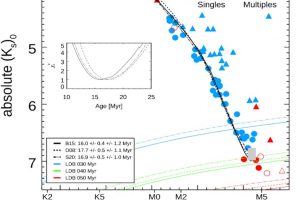A comparison between different diagnostics of the age of stellar clusters. The study: “The Gaia-ESO survey: a lithium depletion boundary age for NGC 2232” of A. S. Binks (Keele University) recently appeared on MNRAS

Measuring stellar ages is a difficult task but nevertheless very important. For instance, the study of stellar evolution requires accurate estimate of stellar ages. On the other hand, we can count on very few diagnostics that can allow astronomers to obtain reliable estimate of stellar ages, and typically these methods can be applied only to specific type of stars or evolutionary stages. A lucky example of this is that of stars in young stellar clusters. Stellar clusters in fact represent coeval sample of stars, which can also be very rich in number, whose age can be estimated with different approaches.
The most frequently used diagnostic consists in comparing magnitudes (which are logarithmic measurements of the energy flux measured in given bands of the electromagnetic spectrum) and colors (differences between magnitudes) of stars in stellar clusters with the values predicted by theoretical models of coeval stars over a large interval of masses. Since these models are called “isochrones”, the method is called “isochrones fitting”. Its diffusion is both due to the fact that it is relatively simple to obtain photometric measurements of stars in clusters, and that there are several models that can be used to this aim. One intrinsic issue of this method is that it relies on the precision at which models describe the complicated physical phenomena occurring in stars. For instance, scientists have shown that these estimate of ages are sensible to how models treat the magnetic phenomena occurring in stars, such as the suppression of convection in presence of photospheric spots. Another method typically used by astronomers consists in measuring the abundance of Lithium in stars, in order to verify at which luminosity stars in a cluster become depleted of this element (“Lithium Depletion Boundary” method). Lithium is in fact rapidly consumed by the processes occurring inside the stars, over a timescale which depends on stellar masses. Thus, by measuring the luminosity (which depends on stellar masses) at which stars are depleted from lithium it is possible to derive an estimate of the age of the cluster.
The team led by the astronomer A. S. Binks (Astrophysics Group, Keele University) analyzed the spectroscopic data, obtained in the framework of the Gaia-ESO Survey (GES), of the stellar cluster NGC 2232, to estimate its age with different diagnostics. The authors have selected the stars associated with the cluster from diagnostics based on stellar spectroscopy and both stellar proper motions and parallaxes, which are obtained from observations of the Gaia satellite of the European Space Agency. These observations have also allowed the authors to measure the distance of the cluster (about 1053 light years from the Sun). The age of the cluster was then measured with two different approaches: “lithium depletion boundary” and “isochrones fitting”. The latter was applied using both models that do not include magnetic phenomena occurring in stars (which are the most commonly used), and models including magnetic phenomena. From the “lithium depletion boundary” the authors estimated an age of about 38 million of years, which is about twice the age obtained with the “isochrones fitting” without accounting for magnetic phenomena. The agreement between the age estimated with the two methods improves by adopting models which account for magnetic phenomena. The best agreement is obtained using models accounting for the presence of spots covering more than 50% of stellar surface, which is common in young and magnetically active stars. This study, described in the paper: “The Gaia-ESO survey: a lithium depletion boundary age for NGC 2232“, recently appeared on the Monthly Notices of the Royal Astronomical Society, thus suggests that existing age estimate of stellar clusters based on the “isochrones fitting” using models that do not account for magnetic phenomena in stars may be wrong even by a factor two. One of the coauthors of this study is the astronomer L. Prisinzano of INAF – Astronomical Observatory of Palermo.
The figure (click here to visualize the entire image) shows a color-magnitude diagram (which is a plot of the absolute magnitude in the K band vs. the intrinsic color G-K, where “G” is the broad band of the photometric measurements obtained with Gaia) of the stars in NGC 2232. Lithium-rich and lithium-depleted stars are marked with red and blue symbols, respectively. Empty and filled symbols instead mark stars with a lithium equivalent width (which is a measure of the intensity of lines in spectra) consistent and not consistent with 300 mÅ, respectively. Circles and triangles mark single and binary stars. The gray box shows the Lithium Depletion Boundary obtained in this study. The blue, green, and red lines mark the models with a 99% lithium depletion at 30, 40, and 50 million of years. Black lines mark the isochrones derived from these models.
